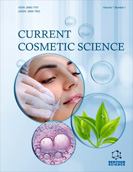Abstract
Background: The design and characteristics of alginate biomaterial have a significant role in wound dressing and tissue regeneration. The ideal biomaterial for wound dressing must be biodegradable, biocompatible, non-inflammatory, and non-toxic.
Objective: Wound dressing should promote the re-epithelization process and protect the wound from further infection by creating a moist environment. The physical and mechanical nature of the alginate biopolymer has the potential to influence the pathophysiological mechanisms in the chronic wound. The application of this biomaterial provides ample advantages than synthetic polymers.
Methods: The wound healing process is a critical step involved in different phases. The presence of cross-linkers, various drugs along with alginate leads to a decrease in the mechanical property of dressing. Hence the choice of an effective material for dressing along with alginate is a very critical decision. The therapeutic efficacy of the alginate dressing system (film, hydrogel, wafer, etc.) is influenced by the incorporation of different materials such as bioactive agents, nanoparticles, crosslinkers, nature of the excipients, etc.
Results: The ion exchange occurring between dressing and exudates results in the formation of a gel, due to the presence of glucuronic acid in alginate. This gel absorbs moisture and maintains an appropriate moist environment and actively influences the pathophysiological mechanisms of the chronic wound.
Conclusion: This review provides detailed knowledge to researchers to work with alginate and also knowledge about the incorporation of an appropriate material and its therapeutic efficacy in wound dressing.
Keywords: Alginate, biomaterial, characterization, drug delivery system, tissue engineering, wound dressing.
Graphical Abstract
[http://dx.doi.org/10.1016/j.addr.2017.08.001] [PMID: 28782570]
[http://dx.doi.org/10.2471/BLT.08.059733] [PMID: 19876549]
[http://dx.doi.org/10.1128/CMR.19.2.403-434.2006 ] [PMID: 16614255]
[http://dx.doi.org/10.4103/0970-0358.70717] [PMID: 21321644]
[PMID: 12768127]
[http://dx.doi.org/10.1038/sj.jid.5700613] [PMID: 17299435]
[http://dx.doi.org/10.1073/pnas.0507250102] [PMID: 16203973]
[http://dx.doi.org/10.1038/nm1328] [PMID: 16288281]
[http://dx.doi.org/10.1186/s13054-015-0961-2] [PMID: 26067660]
[http://dx.doi.org/10.1097/BCR.0b013e31827039a6 ] [PMID: 23446645]
[http://dx.doi.org/10.1016/j.burns.2009.06.208] [PMID: 19765907]
[http://dx.doi.org/10.1016/S0899-5885(18)30830-X ] [PMID: 2357324]
[http://dx.doi.org/10.1097/BCR.0b013e31815f3876 ] [PMID: 18182930]
[http://dx.doi.org/10.1097/00024382-199601000-00004 ] [PMID: 8821097]
[http://dx.doi.org/10.1016/j.ccc.2016.06.001] [PMID: 27600122]
[http://dx.doi.org/10.1186/1757-7241-17-14] [PMID: 19284591]
[http://dx.doi.org/10.1097/BCR.0b013e31820ab019 ] [PMID: 21252688]
[http://dx.doi.org/10.1371/journal.pone.0073992] [PMID: 24086305]
[http://dx.doi.org/10.1136/bmj.328.7453.1427] [PMID: 15191982]
[http://dx.doi.org/10.1016/j.burns.2013.04.026] [PMID: 23768707]
[http://dx.doi.org/10.1097/00000658-197410000-00031 ] [PMID: 4412350]
[http://dx.doi.org/10.2165/00063030-200418020-00004 ] [PMID: 15046526]
[http://dx.doi.org/10.1007/s40204-018-0083-4] [PMID: 29446015]
[http://dx.doi.org/10.1016/j.progpolymsci.2011.06.003 ] [PMID: 22125349]
[http://dx.doi.org/10.1155/2016/7697031]
[http://dx.doi.org/10.12968/jowc.2000.9.2.26338] [PMID: 11933281]
[http://dx.doi.org/10.1007/s11033-018-4296-3] [PMID: 30094529]
[http://dx.doi.org/10.1016/j.jconrel.2006.04.017] [PMID: 16828914]
[PMID: 26286189]
[http://dx.doi.org/10.1111/j.1524-4725.1992.tb02773.x ] [PMID: 1430558]
[http://dx.doi.org/10.1002/(SICI)1097-4636(1999)48:4<522:AID-JBM18>3.0.CO;2-O] [PMID: 10421696]
[PMID: 12149603]
[http://dx.doi.org/10.1002/jbm.a.32096] [PMID: 18523947]
[http://dx.doi.org/10.3390/pharmaceutics10020042 ] [PMID: 29614804]
[http://dx.doi.org/10.1111/j.1524-475X.2009.00503.x ] [PMID: 19614916]
[http://dx.doi.org/10.1111/j.1742-4801.2005.00101.x ] [PMID: 16722867]
[http://dx.doi.org/10.1007/978-1-4615-2197-6_2]
[http://dx.doi.org/10.1177/0885328217739562] [PMID: 29119880]
[http://dx.doi.org/10.1016/j.addr.2012.09.010]
[http://dx.doi.org/10.1016/j.eurpolymj.2017.12.046]
[http://dx.doi.org/10.1016/j.eurpolymj.2019.109220]
[http://dx.doi.org/10.1002/mabi.201200471] [PMID: 23420700]
[http://dx.doi.org/10.1016/j.ijbiomac.2016.05.006] [PMID: 27151668]
[http://dx.doi.org/10.1016/j.jmbbm.2012.11.010] [PMID: 23274732]
[http://dx.doi.org/10.3390/md13052890] [PMID: 25969981]
[http://dx.doi.org/10.1016/j.jccw.2016.06.001] [PMID: 28053863]
[http://dx.doi.org/10.1080/10601325.2014.882693]
[http://dx.doi.org/10.12968/jowc.2016.25.6.364] [PMID: 27286671]
[http://dx.doi.org/10.7603/s40681-015-0022-9] [PMID: 26615539]
[http://dx.doi.org/10.1136/bmjopen-2016-013289] [PMID: 28336737]
[http://dx.doi.org/10.1089/wound.2012.0401] [PMID: 25126472]
[http://dx.doi.org/10.1016/j.ijpharm.2013.10.046] [PMID: 24211443]
[http://dx.doi.org/10.1016/j.ijbiomac.2012.09.031] [PMID: 23059189]
[http://dx.doi.org/10.1016/j.jphotobiol.2011.06.009 ] [PMID: 21803596]
[http://dx.doi.org/10.1080/1023666X.2011.599923]
[http://dx.doi.org/10.1016/j.carbpol.2015.10.091] [PMID: 26686133]
[http://dx.doi.org/10.1186/s40824-016-0063-5] [PMID: 27274861]
[http://dx.doi.org/10.1016/j.jcis.2018.08.073] [PMID: 30153595]
[http://dx.doi.org/10.1002/jps.22263] [PMID: 20575064]
[http://dx.doi.org/10.1080/10837450.2017.1314492 ] [PMID: 28359224]
[http://dx.doi.org/10.1016/j.jare.2019.04.010] [PMID: 31193385]
[http://dx.doi.org/10.1086/644732] [PMID: 19842981]
[http://dx.doi.org/10.3390/polym10080918] [PMID: 30960843]
[http://dx.doi.org/10.1007/s13346-017-0445-9] [PMID: 29134555]
[http://dx.doi.org/10.1016/j.ijpharm.2012.10.017] [PMID: 23085374]
[http://dx.doi.org/10.1016/j.ijpharm.2006.01.023] [PMID: 16503387]
[http://dx.doi.org/10.1016/j.ijbiomac.2015.04.048] [PMID: 25936500]
[http://dx.doi.org/10.3390/pharmaceutics11040182 ] [PMID: 30991742]
[http://dx.doi.org/10.2147/nano.2006.1.1.15] [PMID: 17722259]
[http://dx.doi.org/10.1002/app.42883]]
[http://dx.doi.org/10.1016/0304-3886(95)00041-8]
[http://dx.doi.org/10.1007/978-1-4939-6840-4_18] [PMID: 28238143]
[http://dx.doi.org/10.3390/ma12111859] [PMID: 31181760]
[http://dx.doi.org/10.1111/j.1742-481X.2011.00774.x ] [PMID: 21470369]
[http://dx.doi.org/10.1155/2015/126041]
[http://dx.doi.org/10.1002/mabi.201000046 ] [PMID: 20533533]
[http://dx.doi.org/10.1039/C5TB02174J ] [PMID: 32263019]
[http://dx.doi.org/10.1016/j.ijbiomac.2019.03.045 ] [PMID: 30851329]
[http://dx.doi.org/10.3233/BME-130956] [PMID: 24642979]
[PMID: 30245913]
[http://dx.doi.org/10.12968/bjcn.2018.23.Sup9.S24]
[http://dx.doi.org/10.1016/j.xphs.2017.09.026] [PMID: 28987501]
[http://dx.doi.org/10.1016/j.carbpol.2018.06.114] [PMID: 30143150]
[http://dx.doi.org/10.1016/j.ijbiomac.2017.06.124]
[http://dx.doi.org/10.1016/j.carbpol.2018.02.003] [PMID: 29580422]
[http://dx.doi.org/10.1002/jps.21210] [PMID: 17963217]
[http://dx.doi.org/10.3390/molecules23040942]
[http://dx.doi.org/10.2174/1389450118666170704132523 ] [PMID: 28676002]
[http://dx.doi.org/10.1089/wound.2014.0561] [PMID: 26989578]















